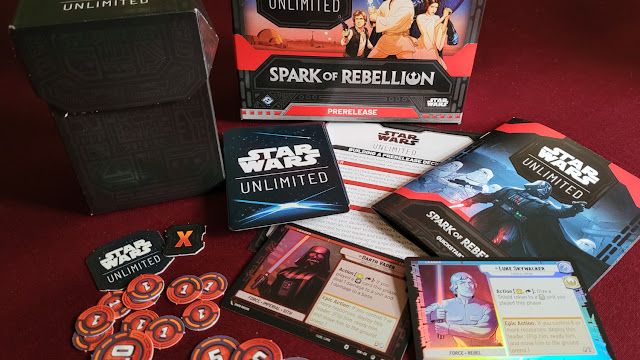First, let’s talk about the miniatures
When the game was first announced, Star Trek: Away Missions came under a bit of criticism over the cartoony style of the miniatures, and I must admit that I initially decided to pass on the game for that reason. Miniatures gamers tend to obsess over scale, with a weird need for all of the miniatures in our collections to be interchangeable or at least consistent – it’s a fairly unreasonable demand that I suspect comes from the same part of the brain that compels some people to collect Funko Pops or Lego minifigures.
However, I was given a chance to take a closer look at the game, first via an OnTableTop.com Let’s Play and later from an open box that the owner of my local game cafe kindly let me paw through. I determined that the game play looked pretty interesting, and the figures were growing on me. The fact that the game definitely plays much more like a board game than a tactical miniatures game (although it has plenty of elements of both, which we’ll get to shortly) helped me to stop comparing the figures to “proper” miniatures, and as it turns out, they have been an absolute joy to paint – you can see some of my efforts on my OnTableTop project blog.
Now let’s talk about the game
There is an emerging category of game that draws heavily on the elements of both miniatures and board games to produce something that is (hopefully) more tactical than your typical board game, but less complicated and labor-intensive than your typical miniatures game. The idea is nothing new, going back at least as far as HeroQuest and Aliens (both published in 1989). Games of this type tend to occupy a sliding scale with “board game with miniatures as playing pieces” at one end and “miniatures with a pre-printed board” at the other, with notable examples including Monolith’s Conan and Mythic Battles, Gale Force Nine’s Firefly Adventures and Aliens: Another GloriousDay in the Corps, and Osprey’s Wildlands and Judge Dredd: HelterSkelter. Star Trek: Away Missions definitely leans towards the board game side of this spectrum, but it does have some tactical elements to it.
The game takes place immediately after the Battle of Wolf 359, the Borg attack on the Federation seen in the Star Trek: the Next Generation fourth season episode “The Best of Both Worlds, Part 2.” The premise of the game is that the players are directing crews to investigate and salvage damaged Federation and Borg vessels in the aftermath of the battle. The board is made up of tiles depicting the interior of a Federation ship on one side and a Borg ship on the other – they are functionally the same but it does allow for some variety between games, as certain goals will be in different places depending on which side players decide to use.
Once the board is set up, the players each begin the game with a crew of four or five characters, and two separate decks of cards, one for missions and one for support cards. The mission cards describe requirements that usually involve moving a character with a particular skill to a specific area of the board and then passing a test by rolling dice. Combat may occasionally break out (also resolved using dice), but for the most part it is a mission solving game, which is in keeping with Star Trek’s themes and ideas of non-violent solutions to problems – the best Star Trek stories are about the heroes cleverly avoiding war and combat, and it’s nice to see that reflected in the game.
The game is played over three rounds, during which players move their characters around the board in an attempt to fulfill the requirements of their mission cards. Support cards can be played to help things along, make it an interesting mix of tactical movement and “right place, right time” card play. Three rounds doesn’t seem like a lot, but in practice it’s plenty of time for a satisfying game, and makes for a nice time limit to keep the game from dragging on for too long.
The characters in the base game, as well as those in the six expansion packs that have been released so far, are all organized into pre-made teams with only a very minor amount of customization available. The game attempts to make up for this by making the mission and support card decks customizable. The idea is that after you play a few games you can pick and choose which missions you want to try to attempt with each crew, and which support cards you think will be of the most use. It’s a concept that should be very familiar to players of trading card games such as Magic: the Gathering, but I think it’s one of this game’s few weak links. It requires players to spend time choosing cards before the game even starts – something that is expected in customizable games but seems a little out of place in what is being presented as more of a traditional board game.
All in all, Star Trek: Away Missions is a nice mix of board game and tactical miniatures game, leaning into the strengths of each type of game. And you will end up finding those goofy looking miniatures charming, I promise...
Rating: 4 (out of 5) With its emphasis on mission solving elements rather than combat, this really does seem like the best choice for a Star Trek miniatures game.- Star Trek: AwayMissions official website
- Star Trek: AwayMissions on BoardGameGeek













